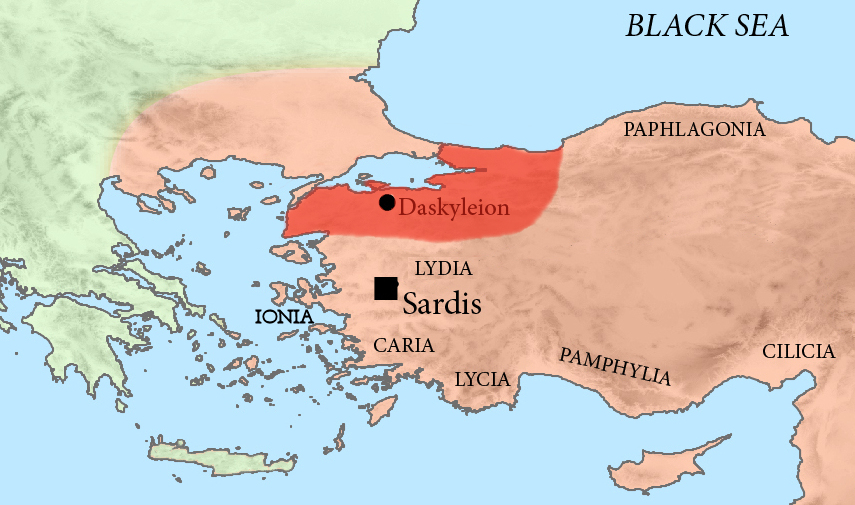Arsites on:
[Wikipedia]
[Google]
[Amazon]

 Arsites ( peo, *R̥šitaʰ; grc, Ἀρσίτης ; fa, آرستیس) was Persian
Arsites ( peo, *R̥šitaʰ; grc, Ἀρσίτης ; fa, آرستیس) was Persian

 Arsites ( peo, *R̥šitaʰ; grc, Ἀρσίτης ; fa, آرستیس) was Persian
Arsites ( peo, *R̥šitaʰ; grc, Ἀρσίτης ; fa, آرستیس) was Persian satrap
A satrap () was a governor of the provinces of the ancient Median and Achaemenid Empires and in several of their successors, such as in the Sasanian Empire and the Hellenistic empires.
The satrap served as viceroy to the king, though with cons ...
of Hellespontine Phrygia
Hellespontine Phrygia ( grc, Ἑλλησποντιακὴ Φρυγία, Hellēspontiakē Phrygia) or Lesser Phrygia ( grc, μικρᾶ Φρυγία, mikra Phrygia) was a Persian satrapy (province) in northwestern Anatolia, directly southeast of ...
in the Achaemenid Empire in the 4th century BC. His satrapy also included the region of Paphlagonia
Paphlagonia (; el, Παφλαγονία, Paphlagonía, modern translit. ''Paflagonía''; tr, Paflagonya) was an ancient region on the Black Sea coast of north-central Anatolia, situated between Bithynia to the west and Pontus to the east, and ...
.
In 340 BC, he sent a mercenary force under the leadership of the Athenian Apollodorus to defend Perinthos, which was besieged by Philip II of Macedon
Philip II of Macedon ( grc-gre, Φίλιππος ; 382 – 21 October 336 BC) was the king ('' basileus'') of the ancient kingdom of Macedonia from 359 BC until his death in 336 BC. He was a member of the Argead dynasty, founders of the a ...
, possibly at Artaxerxes III
Ochus ( grc-gre, Ὦχος ), known by his dynastic name Artaxerxes III ( peo, 𐎠𐎼𐎫𐎧𐏁𐏂𐎠 ; grc-gre, Ἀρταξέρξης), was King of Kings of the Achaemenid Empire from 359/58 to 338 BC. He was the son and successor of ...
's request. The operation was successful and prevented a further advance of Philip into Asia Minor
Anatolia, tr, Anadolu Yarımadası), and the Anatolian plateau, also known as Asia Minor, is a large peninsula in Western Asia and the westernmost protrusion of the Asian continent. It constitutes the major part of modern-day Turkey. The ...
.
In the spring of 334 BC, however, Alexander the Great
Alexander III of Macedon ( grc, Ἀλέξανδρος, Alexandros; 20/21 July 356 BC – 10/11 June 323 BC), commonly known as Alexander the Great, was a king of the ancient Greek kingdom of Macedon. He succeeded his father Philip II to ...
, after crossing the Hellespont
The Dardanelles (; tr, Çanakkale Boğazı, lit=Strait of Çanakkale, el, Δαρδανέλλια, translit=Dardanéllia), also known as the Strait of Gallipoli from the Gallipoli peninsula or from Classical Antiquity as the Hellespont ( ...
, set foot in Asia Minor in the dominion of Arsites. Arsites then took part in the satrap coalition to counter the attacker. In the consequent war-council of Zelea he was foremost in opposing the scorched earth
A scorched-earth policy is a military strategy that aims to destroy anything that might be useful to the enemy. Any assets that could be used by the enemy may be targeted, which usually includes obvious weapons, transport vehicles, commun ...
plan presented by the mercenary Memnon. In the battle of the Granicus
The Battle of the Granicus in May 334 BC was the first of three major battles fought between Alexander the Great of Macedon and the Persian Achaemenid Empire. The battle took place on the road from Abydus to Dascylium, at the crossing of the G ...
, he commanded the Paphlagonian cavalry in the left Persian wing just to the right of Arsames
Arsames ( peo, 𐎠𐎼𐏁𐎠𐎶 Aršāma, modern Persian:،آرسام، آرشام Arshām, Greek: ) was the son of Ariaramnes and the grandfather of Darius I. He was traditionally claimed to have briefly been king of Persia during th ...
and Memnon of Rhodes
Memnon of Rhodes (Greek: Μέμνων ὁ Ῥόδιος; c. 380 – 333 BC) was a prominent Rhodian Greek commander in the service of the Persian Achaemenid Empire. Related to the Persian aristocracy by the marriage of his sister to the satrap ...
.
Arsites fled from the battlefield at Granicus, but shortly afterwards committed suicide feeling that the blame for the defeat should fall on him. His province was the first on Asian soil to fall into the hands of Alexander. Alexander then appointed one of his generals, Calas
The Canadian Association for Laboratory Animal Science (CALAS), a not-for-profit membership association was formed in 1962.
CALAS has 900 members, being veterinarians, physicians, researchers, administrators and technicians. The national office is ...
, as the new satrap of the province.
Arsites had a son named Mithropastes who fled to an island in the Persian Gulf after his father's death. In 325/4 BC he was taken from the island by the naval commander Nearchos, whom he accompanied on the rest of his voyage.Nearchos, FrGrHist 133 F28.
References
Sources
* * * {{Achaemenid rulers Achaemenid satraps of Hellespontine Phrygia 4th-century BC Iranian people 334 BC deaths Military leaders of the Achaemenid Empire Persian people of the Greco-Persian Wars